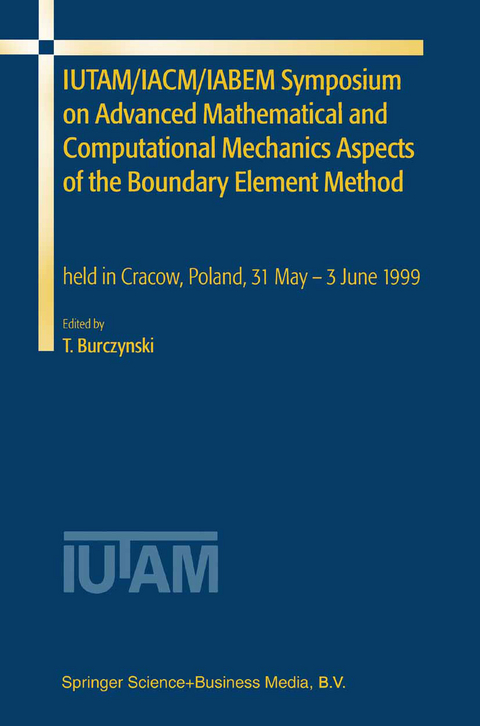
IUTAM/IACM/IABEM Symposium on Advanced Mathematical and Computational Mechanics Aspects of the Boundary Element Method
Springer (Verlag)
978-0-7923-7081-9 (ISBN)
During the last two decades the boundary element method has experienced a remarkable evolution. Contemporary concepts and techniques leading to the advancements of capabilities and understanding of the mathematical and computational aspects of the method in mechanics are presented. The special emphasis on theoretical and numerical issues, as well as new formulations and approaches for special and important fields of solid and fluid mechanics are considered. Several important and new mathematical aspects are presented: singularity and hypersingular formulations, regularity, errors and error estimators, adaptive methods, Galerkin formulations, coupling of BEM-FEM and non-deterministic (stochastic and fuzzy) BEM formulations. Novel developments and applications of the boundary element method in various fields of mechanics of solids and fluids are considered: heat conduction, diffusion and radiation, non-linear problems, dynamics and time-depending problems, fracture mechanics, thermoelasticity and poroelasticity, aerodynamics and acoustics, contact problems, biomechanics, optimization and sensitivity analysis problems, ill posed and inverse problems, and identification problems.
A dual reciprocity boundary element formulation for transient non-linear conduction-radiation problems.- A general algorithm for the direct numerical evaluation of element integrals in the 2D Galerkin BEM.- Applications of boundary integral equations for solving some identification problems in elasticity.- Evolutionary BEM computation in shape optimization problems.- A regularized direct symmetric galerkin BIE formulation for three-dimensional elastoplasticity.- Implementation of symmetric galerkin boundary element in quasi-brittle fracture mechanics.- On the true and spurious eigensolutions using circulants for real-part dual BEM.- Hypersingular formulation for 3-D fracture mechanics. A simple numerical approach.- Shape identification of 3-D obstacles.- Integral transform methods in 3-D dynamic fracture mechanics.- Solution of plane thermoelasticity problems of fracture mechanics by the displacement and temperature discontinuity method.- Investigating unnamed singularities.- Boundary element method, homogenization and heat conduction in composit materials.- Some mathematical aspects of the BEM in elastic scattering of acoustic waves.- Non-singular reciprocity based BEM/FEM formulation.- Numerical analysis of biological tissue freezing process.- Analysis of bio-heat transfer in the system blood vessel — biological tissue.- Rigid inclusions in frictionless unilateral contact with the matrix: identification of maximum stiffness structures by means of BEM formulations and sensitivity analyses.- Numerical model of cast composite solidification.- Recent developments on a boundary element method in aerodynamics.- Application of a regularized SGBEM formulation to FEM-BEM coupling in elastostatics.- On a unified procedure for the numerical evaluation of singular andquasi-singular double integrals.- Solving inverse boundary problems in continuous casting utilizing sensitivity coefficients and the Bounary Element Method.- Boundary element method for two-dimensional shallow water acoustic wave propagation.- Solution of fluid dynamics problems in porous media by DRBEM.- Dynamic poroelasticity treated by a time domain boundary element method.- On adaptivity in boundary element method.- Electrophoretic motion of a charged particle.- On incremental boundary element procedures for frictionally constrained interfaces.- Theoretical and computational aspects of the fuzzy boundary element methods.- A boundary integral method for transient heat diffusion in isotropic non-homogenous media.- A comparative study of three systems of boundary integral equations in the potential theory.- HP-adaptive BE modeling of the human ear acoustics.- Quadratic and singular boundary elements for cracks and notches in three dimensions.- Dynamic crack analysis by hypersingular and non-hypersingular time-domain BEM.
| Zusatzinfo | XII, 428 p. |
|---|---|
| Verlagsort | Dordrecht |
| Sprache | englisch |
| Maße | 155 x 235 mm |
| Themenwelt | Mathematik / Informatik ► Mathematik ► Angewandte Mathematik |
| Technik ► Maschinenbau | |
| ISBN-10 | 0-7923-7081-3 / 0792370813 |
| ISBN-13 | 978-0-7923-7081-9 / 9780792370819 |
| Zustand | Neuware |
| Informationen gemäß Produktsicherheitsverordnung (GPSR) | |
| Haben Sie eine Frage zum Produkt? |
aus dem Bereich


